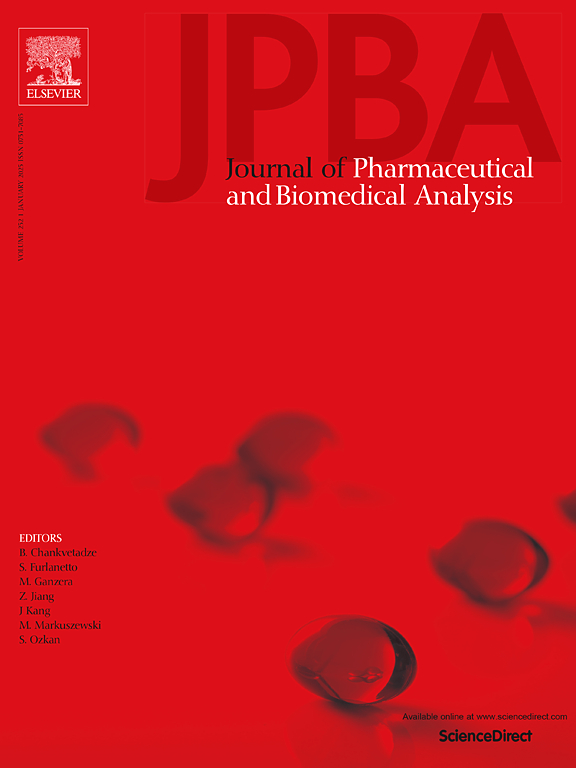Mechanistic insights into Licorice-Evodiae Fructus interaction: UPLC-MS/MS-based hepatotoxic metabolite detection and CYP3A4 regulation study
IF 3.1
3区 医学
Q2 CHEMISTRY, ANALYTICAL
Journal of pharmaceutical and biomedical analysis
Pub Date : 2025-05-22
DOI:10.1016/j.jpba.2025.116985
引用次数: 0
Abstract
Evodiae Fructus (EF) is a hepatotoxic herbal medicine whose toxicity is linked to CYP3A4-mediated metabolic activation of evodiamine (EVD), as identified in our previous study using high-resolution MS platform. In clinic, EF is often combined with Licorice to enhance efficacy and reduce toxicity, but the detoxification mechanism is unknown. In this study, we developed an integrated analytical strategy combining multi-mass spectrometry techniques and biological experiments to investigate the detoxification mechanism of Licorice-EF combination. The changes in EVD serum contents, biochemical indexes and pathological sections in rats were monitored after Licorice administration, and correlation analysis was performed to clarify the detoxification effect of Licorice. In addition, the effect of the major components in Licorice on P450 enzymes and the electrophilic metabolites derived from EVD were investigated by combined application of UPLC-QQQ-MS/MS and UPLC-Q/TOF-MS/MS. Our study showed that the combined use of Licorice and EF in the ratio of 1:1 could significantly ameliorate EF-induced liver injury. The Licorice extract mainly inhibited the activities of CYP3A4, with isoliquiritigenin (ILG) exhibiting the most inhibitory potency with enzyme kinetics parameters kinact and KI at 0.034 min−1 and 0.63 μM, respectively. Furthermore, ILG not only significantly alleviated EVD-induced liver injury, but also obviously reduced the production of EVD-derived reactive metabolites. These results suggested that Licorice alleviated EF-induced liver injury by inhibition of metabolic activation of EF mediated by cytochrome P450s, providing stringent and scientific evidence for such combination from perspectives of metabolism-based interaction.
甘草-茱萸相互作用的机制:基于UPLC-MS/ ms的肝毒性代谢物检测和CYP3A4调节研究
Evodiae Fructus (EF)是一种肝毒性草药,其毒性与cyp3a4介导的EVD (EVD)代谢激活有关,我们之前使用高分辨率MS平台进行了研究。临床上常与甘草合用,以增强疗效、降低毒性,但解毒机制尚不清楚。本研究采用多质谱技术和生物实验相结合的综合分析策略,探讨甘草- ef联合解毒机制。观察甘草给药后大鼠EVD血清含量、生化指标及病理切片的变化,并进行相关性分析,阐明甘草的解毒作用。此外,采用UPLC-QQQ-MS/MS和UPLC-Q/TOF-MS/MS联合应用,研究了甘草主要成分对EVD病原菌P450酶及亲电代谢产物的影响。我们的研究表明,甘草与EF按1:1的比例联合使用可以显著改善EF所致的肝损伤。甘草提取物主要抑制CYP3A4的活性,其中ILG的抑制作用最强,其酶动力学参数kinact和KI分别为0.034 min−1和0.63 μM。此外,ILG不仅能显著减轻evd诱导的肝损伤,还能明显减少evd衍生的反应性代谢物的产生。上述结果提示,甘草通过抑制细胞色素p450介导的EF代谢激活来减轻EF所致的肝损伤,从代谢相互作用的角度为这种联合提供了严格的科学依据。
本文章由计算机程序翻译,如有差异,请以英文原文为准。
求助全文
约1分钟内获得全文
求助全文
来源期刊
CiteScore
6.70
自引率
5.90%
发文量
588
审稿时长
37 days
期刊介绍:
This journal is an international medium directed towards the needs of academic, clinical, government and industrial analysis by publishing original research reports and critical reviews on pharmaceutical and biomedical analysis. It covers the interdisciplinary aspects of analysis in the pharmaceutical, biomedical and clinical sciences, including developments in analytical methodology, instrumentation, computation and interpretation. Submissions on novel applications focusing on drug purity and stability studies, pharmacokinetics, therapeutic monitoring, metabolic profiling; drug-related aspects of analytical biochemistry and forensic toxicology; quality assurance in the pharmaceutical industry are also welcome.
Studies from areas of well established and poorly selective methods, such as UV-VIS spectrophotometry (including derivative and multi-wavelength measurements), basic electroanalytical (potentiometric, polarographic and voltammetric) methods, fluorimetry, flow-injection analysis, etc. are accepted for publication in exceptional cases only, if a unique and substantial advantage over presently known systems is demonstrated. The same applies to the assay of simple drug formulations by any kind of methods and the determination of drugs in biological samples based merely on spiked samples. Drug purity/stability studies should contain information on the structure elucidation of the impurities/degradants.

 求助内容:
求助内容: 应助结果提醒方式:
应助结果提醒方式:


